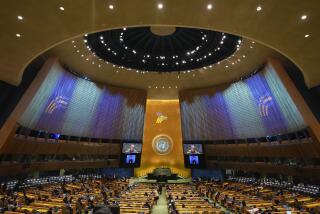U.S., Japan Reach Accord on a New Semiconductor Trade Agreement
SEATTLE â After a marathon 33-hour session, U.S. and Japanese negotiators reached agreement Friday morning on a new semiconductor trade pact, replacing a decade-old agreement established to boost foreign access to Japanâs chip market with a far more modest set of private and government arrangements.
The new deals, hammered out in Vancouver, Canada, by Acting Trade Representative Charlene Barshefsky, Japanese Trade Minister Shunpei Tsukahara and industry representatives includes a new mechanism--applauded by U.S. industry--to monitor the foreign share of Japanâs $45-billion chip market.
In deference to Japanâs desire to move trade talks from a bilateral to multilateral basis, the agreement also calls for the establishment of new government and private forums that would discuss future areas of trade conflict.
âFrankly, Iâm delighted that we got a semiconductor agreement,â President Clinton said Friday.
But the overall vagueness of the agreement raises questions about its meaningfulness and underscores the limitations on American trade policy since the creation last year of the World Trade Organization.
The deal may be more important to the U.S. chip industry as a signal of Clintonâs political commitment to supporting the chip makers, insiders say. Clinton is reportedly keen on closing a deal to maintain the support of political backers in Silicon Valley.
In a parallel set of negotiations, the two sides failed to reach an agreement on opening Japanâs $382-billion insurance market by the July 31 deadline set by Clinton and Japanese Prime Minister Ryutaro Hashimoto.
The 1986 U.S.-Japan Semiconductor Agreement, which was renewed in 1991 and expired Wednesday night, set a 20% target for foreign share of Japanâs market. The target angered Japanese industry, which argued it is overly intrusive, but was put forward by the U.S. side as the model of an effective trade agreement.
During the course of the agreement, foreign share of the Japanese market rose to 31%--triple its level in 1986. And the U.S. chip industry, struggling for survival back in 1986, has come roaring back and now dominates many key markets.
The new âJoint Statementâ by the two governments says nothing about trade access. The only role of the two governments will be to review market trends, cooperative activities and government policies related to the semiconductor industry.
A separate agreement between the U.S. Semiconductor Industry Assn. and the Electronic Industries Assn. of Japan establishes a Semiconductor Council that will collect market share and other data in each country to be periodically reviewed by their respective governments.
âWe see the progress of recent years as somewhat fragile and we wanted to keep some counterweight,â said Ira Shapiro, senior counsel for the U.S. trade representative. âThis gives us access to the data and it keeps the spotlight on the issue. If we see a pattern, we can address it.â
The Japanese government, by contrast, looks at the agreement as the end of American bullying of Japan and the beginning of a new, more multilateral, approach to trade talks.
âWe have put an end to the system of managed trade,â said Tsukahara, Japanâs minister of international trade and industry, in a statement. âWe have created a multilateral framework of cooperation that is appropriate for the new era.â
Japan, which had initially objected vigorously to collecting market-share data, now says the data wonât be significant because the nation has no commitment to respond to any shift in market share.
One senior MITI official said he expects the focus of chip discussions to shift from concern over access to Japan to investigations of market obstacles in other fast-growing Asian countries. The official expects the multilateral approach taken in this agreement to be reflected in future trade agreements with the United States.
The Semiconductor Council (the Japanese prefer to call it the World Semiconductor Council) will be opened to other chip manufacturing nations that have agreed to eliminate tariffs on semiconductor imports. For the moment, that excludes chip producers in Europe, Korea and Taiwan. A separate Global Government Forum will discuss semiconductor issues at the government level.
U.S. officials say the vagueness of the new semiconductor agreement reflects Americaâs success in breaking into the Japanese market and the lack of the need for additional progress.
âOur semiconductor industry is much stronger than it was five or 10 years ago,â a senior U.S. trade negotiator said. âWhen you have a foreign market share of 30% you obviously donât need a similar agreement.â
But other analysts say that with the establishment of the WTO, the United States no longer has the ability to apply the unilateral sanctions it did in 1987 when it forced Japan to comply with the chip agreement.
Americaâs only real trade weapons today are its ability to unilaterally apply anti-dumping and antitrust regulations, said Kenneth Flamm, a Brookings Institution fellow who recently left the Clinton administration and published a book on semiconductor trade between the U.S. and Japan. He suggests the threat of an anti-dumping suit by Micron Technology Inc. may have spurred Japan to make the small concessions it made in the current agreement.
However, Flamm suggests the new multilateral organizations could represent a significant new approach to dealing with trade frictions if the two industries exploit the forums to deal with such contentious issues as intellectual property, government subsidies and cartels.
âItâs a question of whether the forums will be viewed as a political fig leaf or a place to deal with real problems,â he said.






